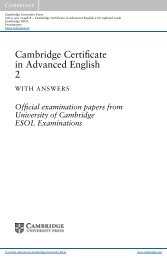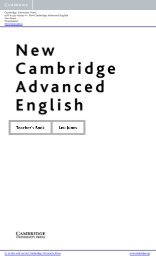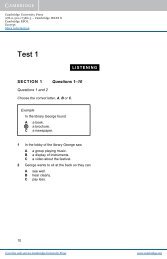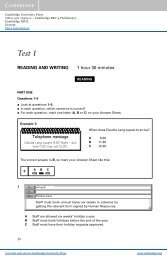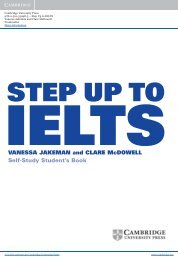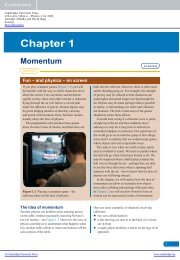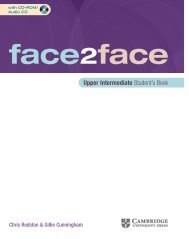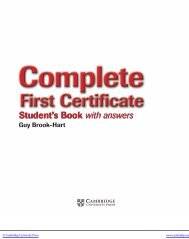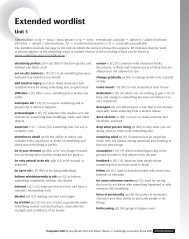Skills for Study Level 2 Teacher's Book - Cambridge University Press
Skills for Study Level 2 Teacher's Book - Cambridge University Press
Skills for Study Level 2 Teacher's Book - Cambridge University Press
You also want an ePaper? Increase the reach of your titles
YUMPU automatically turns print PDFs into web optimized ePapers that Google loves.
2k Student discussionAnswers1 This is arguably untrue. The strength of a conclusion in a quantitative studymay be reduced by a small sample size, but in a case study or ethnographicstudy, a small sample size might be perfectly acceptable. Also, even thougha strong conclusion may not be possible with a small sample size, the resultscan still be suggestive, or exploratory.2 Yes. This is not to say that they are invalid, only that the certainty is reduced.3 Arguably yes. A larger number of measurements is probably more certain inmost cases, but validity does not rest on number of measurements alone.2lSuggested answersThe results suggest that the new workspace design is preferred by the peopleusing it, but not universally. The sample size (30) is relatively small <strong>for</strong> a strongconclusion. There<strong>for</strong>e, the most suitable of the possible conclusions areprobably conclusions B or C.2m Students check their ideas with a partner.Unit Task: Designing buildings <strong>for</strong> human needsaIn pairs, students try to add search terms to a list that they could use to find onlinearticles about the assignment topic.Suggested answers• creativity: creative potential; thinking; thinking ability• physical environment: work / living space; surroundings• work productivity: work rate; output• room design: layout; arrangement• mood: feeling; emotion; emotional state / condition• study: learning; researchbcBe<strong>for</strong>e the next lesson, students use the search terms to find at least one journalarticle reporting research into room / building design.Students read the sources and take notes, considering them in relation to otherin<strong>for</strong>mation they have gathered, and decide how much they agree with thein<strong>for</strong>mation presented in the articles.Note: If the article contains in<strong>for</strong>mation from an experimental study, studentsshould record in<strong>for</strong>mation in the space provided.Note: Ask students to turn to the checklist on p.241 and reread the tips relating toUnit 4 Parts A–B, be<strong>for</strong>e reading the tips to Unit 4 Part C. Encourage students to putthese tips into practice in their studies from now on. Tell them they will be asked toreport back on this in a future lesson.Unit 4 Part C ∙ Investigating 123



